Exploring Thunderbolt 3 eGFX Performance, Feat. PowerColor's Gaming Station & Radeon RX Vega 56 Nano
by Ganesh T S on February 13, 2019 10:00 AM EST- Posted in
- GPUs
- AMD
- Radeon
- PowerColor
- Thunderbolt 3
- eGFX
- RX Vega 56 Nano Edition
UL 3DMark and VRMark
UL's 3DMark comes with a diverse set of graphics workloads that target different Direct3D feature levels. Correspondingly, the rendering resolutions are also different. The VRMark benchmark targets virtual reality specifically. Its workloads are termed as 'rooms', with each one being a piece of VR content designed to require a specific level of VR performance. We used 3DMark 2.4.4264 and VRMark 1.2.1701 to get an idea of the graphics capabilities of various systems. In this section, we take a look at the performance of the Zotac MI553 eGPU on a comparative basis across the different workloads.
3DMark Ice Storm
This workload has three levels of varying complexity - the vanilla Ice Storm, Ice Storm Unlimited, and Ice Storm Extreme. It is a cross-platform benchmark (which means that the scores can be compared across different tablets and smartphones as well). All three use DirectX 11 (feature level 9) / OpenGL ES 2.0. While the Extreme renders at 1920 x 1080, the other two render at 1280 x 720. The graphs below present the various Ice Storm worloads' numbers for different systems that we have evaluated.
| UL 3DMark - Ice Storm Workloads | |||
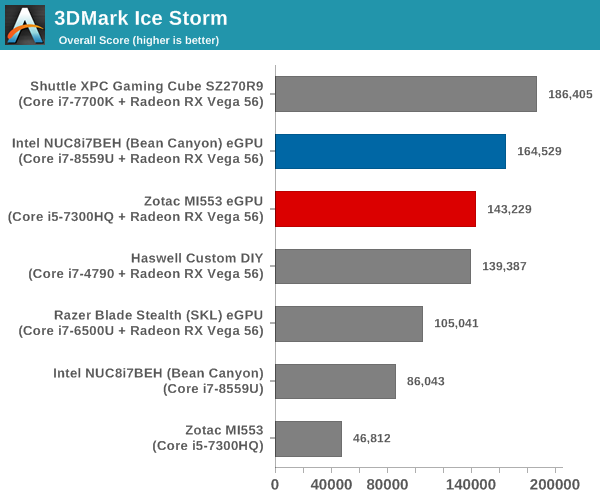
The Ice Storm series of benchmarks is not entirely suited for our test configurations. Benchmark scores above 40000 are quite sensitive to non-GPU factors. As such, those workloads are too simple for the configuration.
3DMark Cloud Gate
The Cloud Gate workload is meant for notebooks and typical home PCs, and uses DirectX 11 (feature level 10) to render frames at 1280 x 720. The graph below presents the overall score for the workload across all the systems that are being compared.
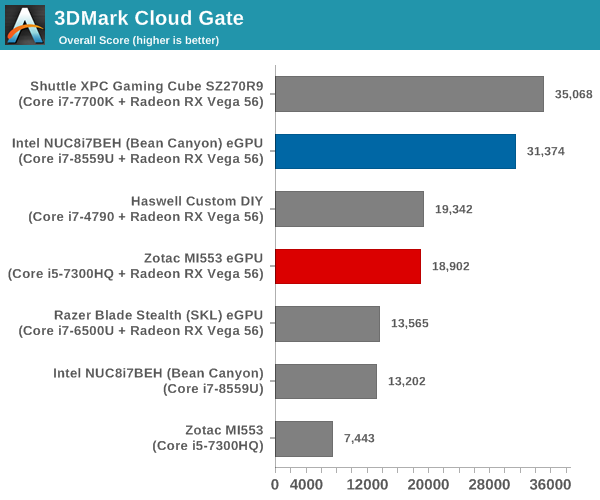
Cloud Gate shows the Shuttle internal GPU configuration coming out on top, as expected. The eGPU solution involving Bean Canyon surprisingly outsmarts the other configurations, showing that this benchmark benefits from CPU power rather than just the PCIe link width.
3DMark Sky Diver
The Sky Diver workload is meant for gaming notebooks and mid-range PCs, and uses DirectX 11 (feature level 11) to render frames at 1920 x 1080. The graph below presents the overall score for the workload across all the systems that are being compared.
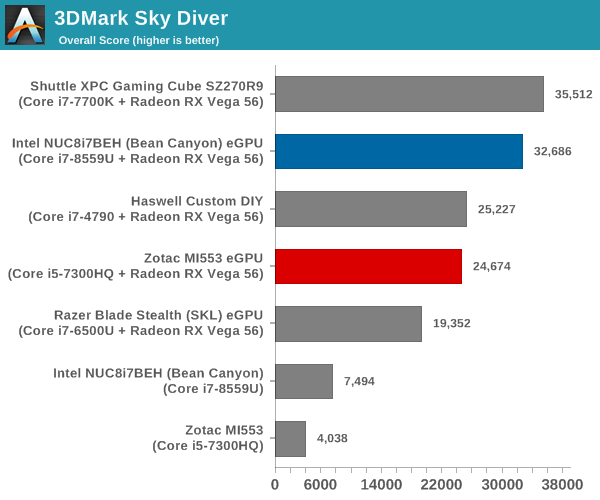
The Sky Diver benchmark results are similar to that of Cloud Gate.
3DMark Fire Strike Extreme
The Fire Strike benchmark has three workloads. The base version is meant for high-performance gaming PCs. Similar to Sky Diver, it uses DirectX 11 (feature level 11) to render frames at 1920 x 1080. The Ultra version targets 4K gaming system, and renders at 3840 x 2160. However, we only deal with the Extreme version in our benchmarking - It renders at 2560 x 1440, and targets multi-GPU systems and overclocked PCs. The graph below presents the overall score for the Fire Strike Extreme benchmark across all the systems that are being compared.

This benchmark sees the two internal GPU solutions on top, indicating that the workload is sensitive to the bandwidth between the host CPU and the GPU (PCIe 3.0 x16 vs. x4 in the other configurations).
3DMark Time Spy
The Time Spy workload has two levels with different complexities. Both use DirectX 12 (feature level 11). However, the plain version targets high-performance gaming PCs with a 2560 x 1440 render resolution, while the Extreme version renders at 3840 x 2160 resolution. The graphs below present both numbers for all the systems that are being compared in this review.
| UL 3DMark - Time Spy Workloads | |||
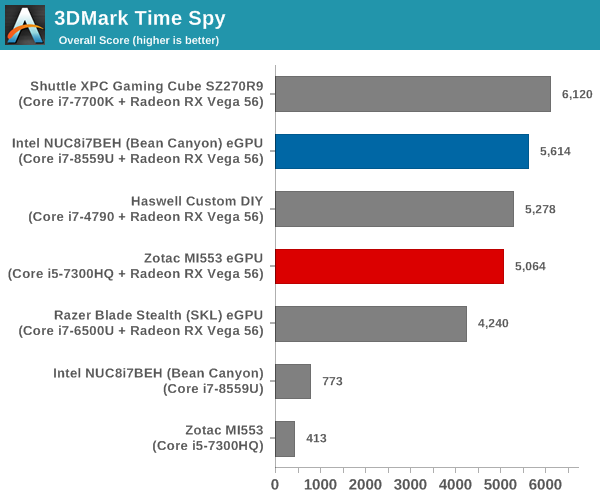
The Time Spy benchmarks are similar to the Cloud Gate and Sky Diver benchmarks in terms of the ordering of the performance of different configurations. Here, the CPU capabilities are more important than the available host-GPU bandwidth.
The VRMark Professional Edition v1.2.1701 comes with three rooms. Each room can be run either in desktop or HMD mode, with varying minimum requirements for the same workload. The benchmark results include the average FPS achieved, and a score based on the FPS. A pass or fail indicator is also provided based on whether the average FPS exceeds the required FPS. In this section, we take a look at the performance of the Zotac MI553 eGPU on a comparative basis across the three workloads in desktop mode.
VRMark Orange Room
The Orange Room is meant to test the effectiveness of a system for handling the requirements of the HTC Vive and the Oculus Rift. The recommended hardware for both VR HMDs should be able to easily achieve the desired target FPS (88.9 fps). However, in the desktop mode, the target performance is 109 fps without any frame drops. Systems benching with an average FPS lesser than that are deemed to have failed the VRMark Orange Room benchmark. The graphs below present the average FPS and score for the different systems being considered today.
| UL VRMark - Orange Room | |||
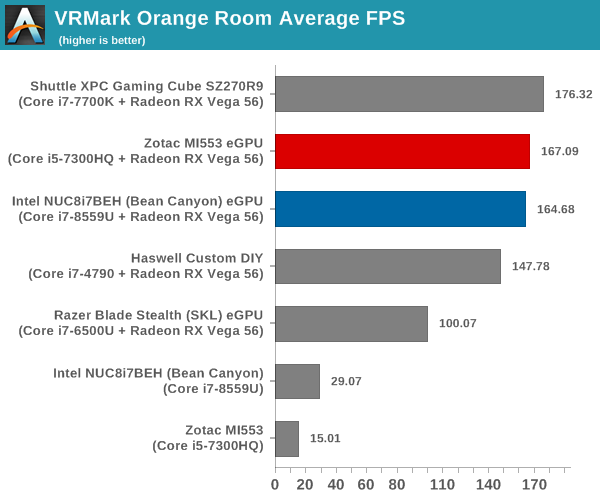
The PowerColor Radeon RX Vega 56 Nano is easily able to pass the VRMark Orange Room test as an eGPU even with an ultrabook as the host.
VRMark Cyan Room
The Cyan Room sits between the Orange and Blue rooms in complexity. It is a DirectX 12 benchmark. Similar to the Orange room, the target metrics are 88.9 fps on HMDs and 109 fps on the desktop monitor. The graphs below present the average FPS and score for the different systems being considered today.
| UL VRMark - Cyan Room | |||
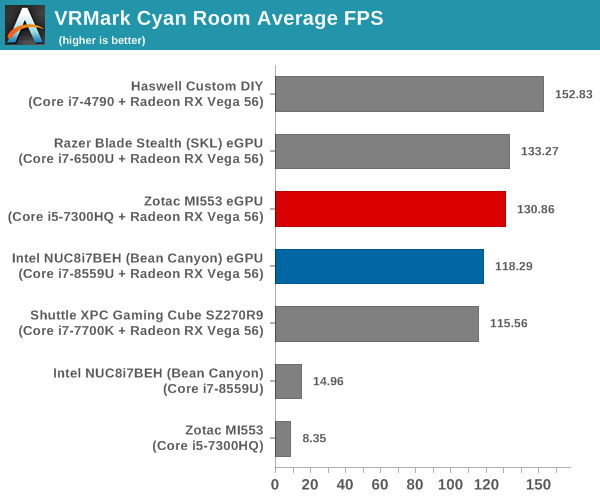
The PowerColor Radeon RX Vega 56 Nano is easily able to pass the VRMark Cyan Room test as an eGPU even with an ultrabook as the host.
VRMark Blue Room
The Blue Room is the most demanding of the three workloads. At the time of introduction of VRMark in October 2016, no publicly available system running as sold was able to pass the test. The performance of a system in this benchmark is an indicator of its VR-readiness for future generation of HMDs. Similar to the other workloads, the passing performance metrics are 88.9 fps on HMDs and 109 fps on desktop monitors. The complexity of the workload is due to the higher resolution (5012 x 2880) and additional geometry making it necessary to increase the number of Direct3D API calls. The graphs below present the average FPS and score for the different systems being considered today.
| UL VRMark - Blue Room | |||
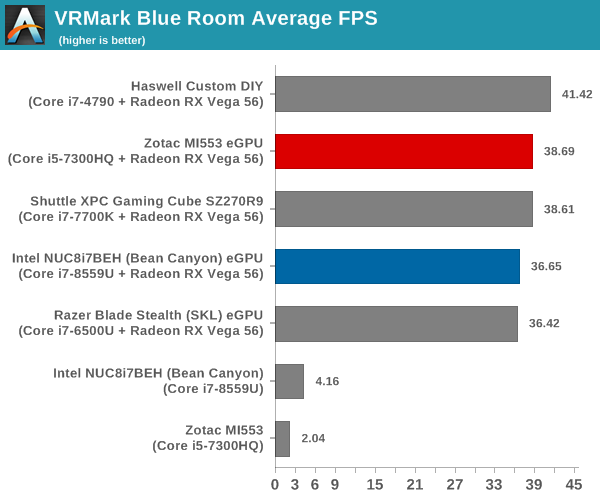
The PowerColor Radeon RX Vega 56 Nano can not pass the VRMark Blue Room test with any of the tested host systems.










25 Comments
View All Comments
OolonCaluphid - Wednesday, February 13, 2019 - link
As a Dan A4 owner, I'm absolutely crying at the size and emptyness of that box!! What an utter waste of space. You can get a whole PC in there, negating the need for an external GPU in the first place.(yeah yeah, I get it, it's for laptops... just build an SFF PC)
Reflex - Wednesday, February 13, 2019 - link
I also have a Dan A4-SFX and that was exactly my first thought! And for about the same price no less!hansmuff - Wednesday, February 13, 2019 - link
I wonder if you could hook up a laptop to a gaming PC. Then, use Laptop keyboard, mouse and display as peripherals. I suppose the laptop would have to accept HDMI or DP as input, and I also suppose few if any do that?DanNeely - Wednesday, February 13, 2019 - link
You're making it too complicated. No need for special hardware functions, when you could remote desktop/etc into a desktop from your laptop.PeachNCream - Thursday, February 14, 2019 - link
Remote Desktop has a bit of trouble with DirectX and though the latency is a lot lower than something like VNC, it isn't intended as a solution for pushing a game's graphics over a network. Steam in-home streaming is a much better option for a local situation like that and you can use it rather effectively with non-Steam games by just adding them to Steam manually. You can also toss in programs like Windows Explorer or the components of an office suite to do something productive via Steam as well. In the end though, I do agree that remote access to a gaming PC from another PC is a layer of complexity that isn't typically necessary although you can, at least in theory, run a headless gaming desktop that way.WinterCharm - Wednesday, February 20, 2019 - link
Steam has a built in game streaming solution that works perfectly for this. You don't need Windows Remote Desktop. You just use Steam's game streaming.29a - Thursday, February 14, 2019 - link
Steam does what you want.JoeTheDestroyr - Thursday, February 14, 2019 - link
I wanted such a thing and couldn't find it. I enjoy the laptop form-factor for playing games in my comfy chair in my living room (and no, for the last time, I don't want to use my tv, I use that for other things).In the end, I had to make it myself. Grabbed a dead laptop off ebay, ripped out the guts, and replaced it w/ a Chinese board off ebay that could drive laptop lcd panels from a DP connection. Made my own usb keyboard controller using a Teensy. Even added a class D amp + USB audio to drive the laptop speakers (which sounded like garbage until I used a calibration mic + Equalizer APO to clean it up).
JoeTheDestroyr - Thursday, February 14, 2019 - link
Stupid no edit:...enjoy the laptop form-factor for playing games in my comfy chair in my living room, but got tired of the ridiculous markup (and simultaneous lack of performance) on gaming laptops. And I don't care about portability, just "lap-ability" (moving it from a table to my lap, and back).
watersb - Friday, February 15, 2019 - link
Dang. That sounds like my kind of game. :-)